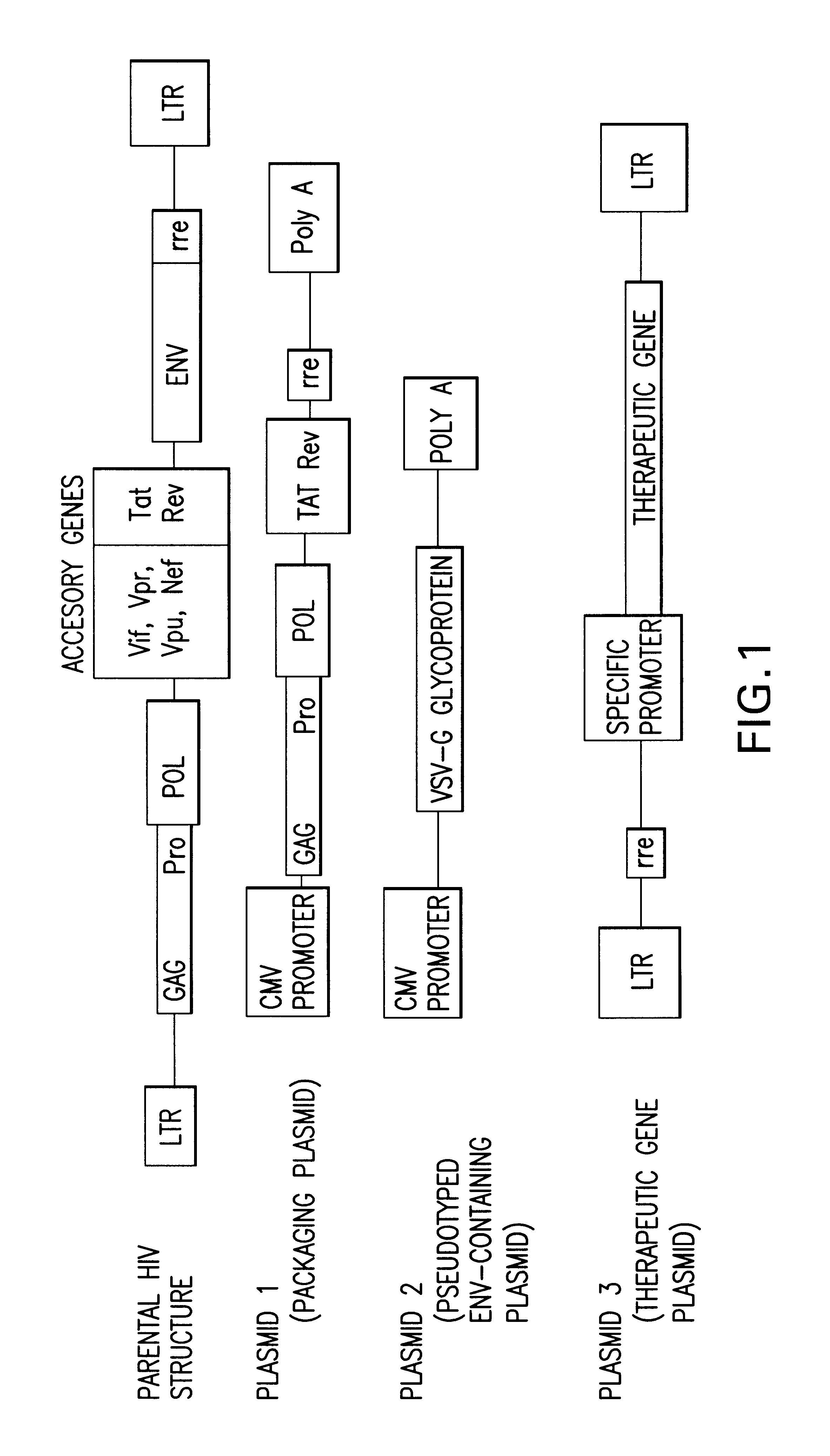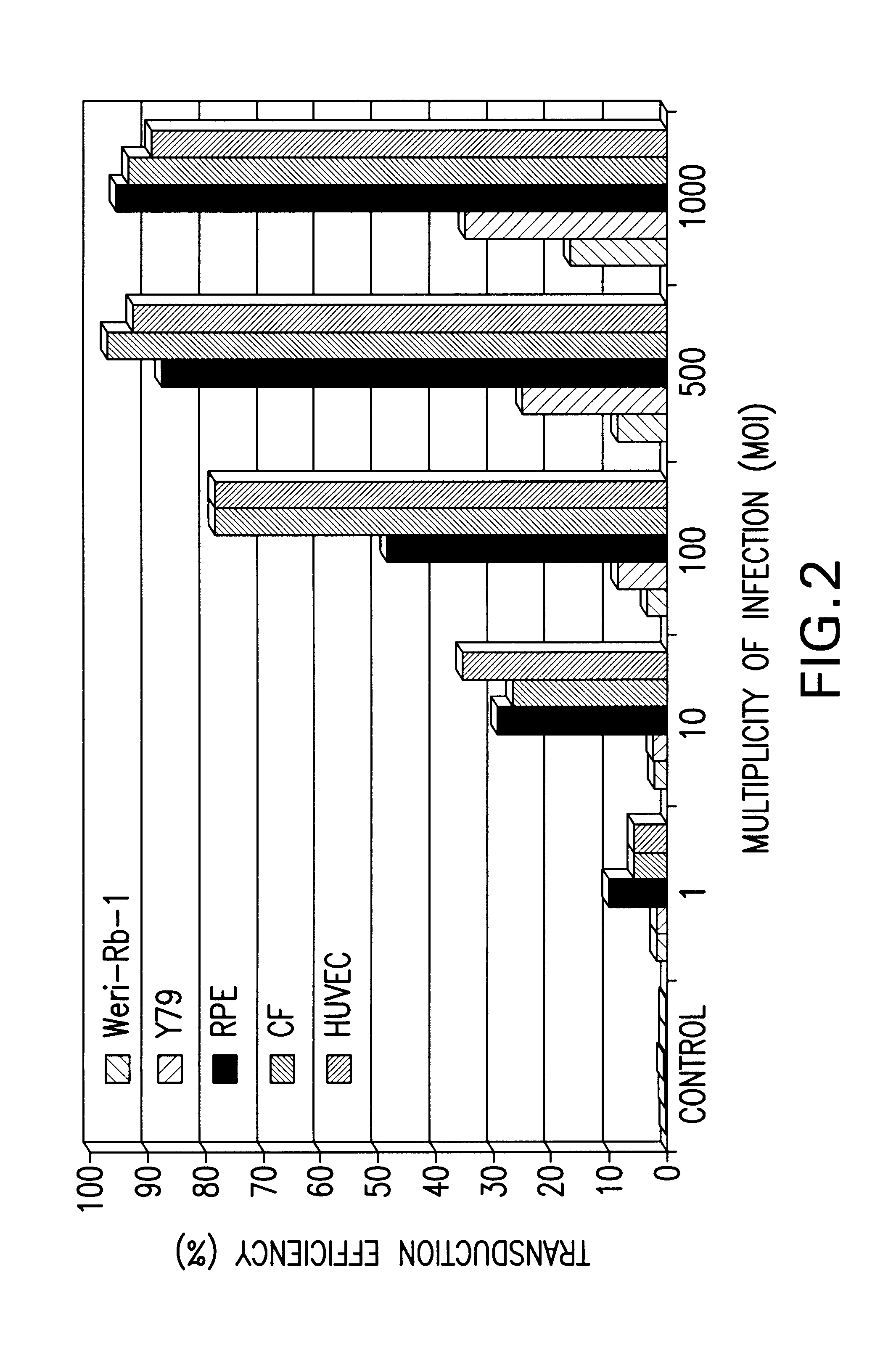Lentiviral vector-mediated gene transfer and uses thereof
a technology of lentiviral vectors and gene transfer, applied in the field of lentiviral vectormediated gene transfer and its use, can solve the problems of loss of visual axis clarity or separation of retina, permanent loss of vision, and compromising retinal function
- Summary
- Abstract
- Description
- Claims
- Application Information
AI Technical Summary
Benefits of technology
Problems solved by technology
Method used
Image
Examples
example 1
Cells and Tissue
[0112]Primary explants of human choroidal fibroblasts (HCF), human umbilical vein endothelial cells (HUVEC) and human fetal retinal pigment epithelial cells (HRPE) were established and were plated in conditions which either did or did not promote mitotic activity. Stable photoreceptor-derived cells (Y-79 and Weri-Rb-1) were also cultured.
[0113]Human retina and RPE, obtained at the time of enucleation for retinoblastoma were used to demonstrate the ability of lentiviral vectors to transduce these mitotically inactive cells and induce the expression of an exogenous human peripherin transgene. Human corneas obtained at the time of corneal transplant surgery were used to demonstrate the ability of lentiviral vectors to transduce these mitotically inactive cells with the marker gene enhanced green fluorescence protein gene.
example 2
Lentivirus Vector
[0114]A three plasmid-based lentiviral vectoring system pseudotyped with the vesicular stomatitis virus (VSV) envelope and which contained the green fluorescent protein (GFP) gene as a marker was used (FIG. 1). Recombinant lentiviruses were produced as described by Naldini et al. The cytomegalovirus (CMV) immediate-early gene promoter directed expression of eGFP in the plasmid pHR′-CMV-eGFP. Stocks of virus were generated as follows. Human kidney 293T cells (5×106) were plated on 10 cm plates, and were cotransfected the following day with 10 ug of pCMVΔR8.91 (packaging function plasmid), 10 ug of pHR′-CMV-eGFP (marker gene plasmid), and 2 ug of pMD.G (the VSV-G envelope containing plasmid) by calcium phosphate precipitation in D10 growth medium (high glucose DMEM with 10% fetal bovine serum) and antibiotics. After 12-16 h at 37° C., the medium was removed and fresh D10 growth medium was added. Cells were cultured for an additional 10 hours. Fresh D10 medium containi...
example 3
Lentivirus Vector Transduction
[0117]Supernatants containing 2×106 replication-deficient lentiviral particles / ml were generated by the transfection of 293T cells with the lentivirus vector described above. Cells were cultured with the viral particles for 24 hours and then recovered in normal media for four days prior to the determination of GFP expression by fluorescent-activated cell sorting (FIGS. 2-3).
[0118]Transduction efficiency was measured as a function of multiplicity of infection with MOIs ranging from 1 to 1000. Results of in vitro transduction of a number of human cell lines demonstrate a positive correlation between MOI and transduction efficiency as more cells were transduced with increasing number of lentiviral particles (FIG. 2).
[0119]The ability of the lentiviral vector to transduce non-dividing cells was examined. Human retinal pigment epithelial cells were transduced by lentiviral or murine leukemia viral vectors. Cells were mitotically inactive (confluent) or mitot...
PUM
| Property | Measurement | Unit |
|---|---|---|
| green fluorescent protein | aaaaa | aaaaa |
| concentration | aaaaa | aaaaa |
| fluorescent | aaaaa | aaaaa |
Abstract
Description
Claims
Application Information
 Login to View More
Login to View More - R&D
- Intellectual Property
- Life Sciences
- Materials
- Tech Scout
- Unparalleled Data Quality
- Higher Quality Content
- 60% Fewer Hallucinations
Browse by: Latest US Patents, China's latest patents, Technical Efficacy Thesaurus, Application Domain, Technology Topic, Popular Technical Reports.
© 2025 PatSnap. All rights reserved.Legal|Privacy policy|Modern Slavery Act Transparency Statement|Sitemap|About US| Contact US: help@patsnap.com



